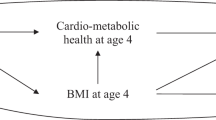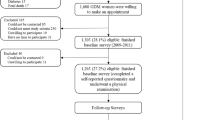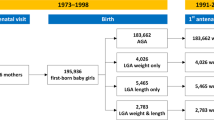Abstract
Background/Objectives:
Prenatal growth, which is widely marked by birthweight, may have a pivotal role in affecting the lifelong risk of cardiometabolic disorders; however, comprehensive evaluation of its relations with childhood cardiometabolic risk patterns and the ethnic and gender disparities in national representative populations is still lacking. The aim of this study was to evaluate the associations between birthweight and comprehensive patterns of cardiometabolic risk in a nationally representative sample of children and adolescents.
Subjects/Methods:
Prospective analyses were performed using data from 28 153 children 0 to 15 years in the National Health and Nutrition Examination Survey from 1999 through 2014. We defined childhood cardiometabolic disorders using standard definitions for obesity, high blood pressure, hyperglycemia and dyslipidemia.
Results:
Five birthweight categories <2.5, 2.5–3.0, 3.0–3.5, 3.5–4.2 and ⩾4.2 kg accounted for 8.2%, 17.9%, 35.7%, 27.9% and 10.4% of the population, respectively. In all children, with increasing birthweight, we observed significantly increasing trends of the risk of general and central obesity (P for trend <0.01) and significantly decreasing trends of the risk of high systolic blood pressure (SBP), high HbA1c and low high-density lipoprotein cholesterol (HDL-C) (P for trend <0.05). The associations were independent of current body mass index (BMI). In addition, we found that the relations of birthweight with high waist circumference in Black children showed U-shape, as well as high SBP in Mexican and Hispanic children. Moreover, we found that the associations of low birthweight with high SBP and low HDL-C appeared to more prominent significant in boys, whereas the inverse association with high HbA1c was more evident in girls.
Conclusions:
Our data indicate that birthweight is significantly related to childhood cardiometabolic risk, independent of current BMI, and the associations exhibit race and gender-specific patterns.
This is a preview of subscription content, access via your institution
Access options
Subscribe to this journal
Receive 12 print issues and online access
$259.00 per year
only $21.58 per issue
Buy this article
- Purchase on Springer Link
- Instant access to full article PDF
Prices may be subject to local taxes which are calculated during checkout



Similar content being viewed by others
References
Vickers MH, Breier BH, Cutfield WS, Hofman PL, Gluckman PD . Fetal origins of hyperphagia, obesity, and hypertension and postnatal amplification by hypercaloric nutrition. Am J Physiol Endocrinol Metab 2000; 279: E83–E87.
Singhal A, Wells J, Cole TJ, Fewtrell M, Lucas A . Programming of lean body mass: a link between birth weight, obesity, and cardiovascular disease? Am J Clin Nutr 2003; 77: 726–730.
Inadera H . Developmental origins of obesity and type 2 diabetes: molecular aspects and role of chemicals. Environ Health Prevent Med 2013; 18: 185–197.
Gluckman PD . Living with the past: evolution, development, and patterns of disease. Science 2004; 305: 1733–1736.
Newsome CA, Shiell AW, Fall CHD, Phillips DIW, Shier R, Law CM . Is birth weight related to later glucose and insulin metabolism?–A systematic review. Diabet Med 2003; 20: 339–348.
Benyshek DC, Martin JF, Johnston CS . A reconsideration of the origins of the type 2 diabetes epidemic among Native Americans and the implications for intervention policy. Med Anthropol 2001; 20: 25–64.
Harder T, Rodekamp E, Schellong K, Dudenhausen JW, Plagemann A . Birth weight and subsequent risk of type 2 diabetes: a meta-analysis. Am J Epidemiol 2007; 165: 849–857.
McCance DR, Pettitt DJ, Hanson RL, Jacobsson LT, Knowler WC, Bennett PH . Birth weight and non-insulin dependent diabetes: thrifty genotype, thrifty phenotype, or surviving small baby genotype? BMJ Clin Res Ed 1994; 308: 942–945.
Whincup PH, Kaye SJ, Owen CG, Huxley R, Cook DG, Anazawa S et al. Birth weight and risk of type 2 diabetes: a systematic review. JAMA 2008; 300: 2886–2897.
Tirosh A, Shai I, Afek A, Dubnov-Raz G, Ayalon N, Gordon B et al. Adolescent BMI trajectory and risk of diabetes versus coronary disease. N Engl J Med 2011; 364: 1315–1325.
Reilly JJ, Kelly J . Long-term impact of overweight and obesity in childhood and adolescence on morbidity and premature mortality in adulthood: systematic review. Int J Obes 2011; 35: 891–898.
Baker JL, Olsen LW, Sørensen TIA . Childhood body-mass index and the risk of coronary heart disease in adulthood. N Engl J Med 2007; 357: 2329–2337.
Ogden CL, Flegal KM, Carroll MD, Johnson CL . Prevalence and trends in overweight among US children and adolescents, 1999-2000. JAMA 2002; 288: 1728.
Huxley R, Neil A, Collins R . Unravelling the fetal origins hypothesis: is there really an inverse association between birthweight and subsequent blood pressure? Lancet (Lond, Engl) 2002; 360: 659–665.
Huxley R, Owen CG, Whincup PH, Cook DG, Colman S, Collins R . Birth weight and subsequent cholesterol levels: exploration of the ‘fetal origins’ hypothesis. JAMA 2004; 292: 2755–2764.
Watson P, Wall C In: Essentials of Human Nutrition, (Pregnancy and lactation) vol. 41, Oxford University Press, 2003, pp 99.
Kuczmarski RJ, Ogden CL, Guo SS, Grummer-Strawn LM, Flegal KM, Mei Z et al. 2000 CDC Growth Charts for the United States: methods and development. Vital Health Stat 11 2002; 1–190. Available at: http://www.ncbi.nlm.nih.gov/pubmed/12043359.
Zimmet P, Alberti KGM, Kaufman F, Tajima N, Silink M, Arslanian S et al. The metabolic syndrome in children and adolescents - an IDF consensus report. Pediatr Diabetes 2007; 8: 299–306.
National High Blood Pressure Education Program Working Group on High Blood Pressure in Children and Adolescents. The fourth report on the diagnosis, evaluation, and treatment of high blood pressure in children and adolescents. Pediatrics 2004; 114: 555–576 Available at: http://care.diabetesjournals.org/content/39/Supplement_1/S4.long.
Standards of Medical Care in Diabetes-2016: Summary of Revisions. Diabetes Care 2016; 39 (Suppl 1): S4–S5.
Kavey REW, Daniels SR, Lauer RM, Atkins DL, Hayman LL, Taubert K . American Heart Association guidelines for primary prevention of atherosclerotic cardiovascular disease beginning in childhood. Circulation 2003; 107: 1562–1566.
Alberti SG, Zimmet P . The IDF Consensus definition of the metablic syndrome in children and adolescents. Int Diabetes Federation 2007; 24.
SR Daniels, I Benuck, BA Dennison, SS Giding, MW, Gillman, et al. Expert Panel on Integrated Guidelines for Cardiovascular Health and Risk Reduction in Children and Adolescents. National Heart Lung and Blood Institute, NIH Publication No. 12-7486, 216 (2012). Available at: https://www.nhlbi.nih.gov/files/docs/guidelines/peds_guidelines_full.pdf.
Daniels SR, Greer FR Committee on Nutrition. Lipid screening and cardiovascular health in childhood. Pediatrics 2008; 122: 198–208.
Levy PS, Lemeshow S . Sampling of Populations: Methods and Applications. John Wiley & Sons: NJ, USA, 2013. Available at: https://books.google.com/books?id=XU9ZmLe5k1IC&pgis=1.
Yeo D, Mantel HJ, Liu T-P . Bootstrap variance estimation for the National Population Health Survey. JSM 1999 Proceedings of the Survey Research Methods Section 1999; 778–785. Available at: http://www.amstat.org/sections/srms/proceedings/papers/1999_136.pdf.
Shao J, Tu D . The Jackknife and Bootstrap. Springer Science & Business Media: Berlin, 2012. Available at: https://books.google.com/books?id=VO3SBwAAQBAJ&pgis=1.
Schellong K, Schulz S, Harder T, Plagemann A, King D, Mokdad A et al. Birth weight and long-term overweight risk: systematic review and a meta-analysis including 643902 persons from 66 studies and 26 countries globally. PLoS One 2012; 7: e47776.
Huxley RR, Shiell AW, Law CM . The role of size at birth and postnatal catch-up growth in determining systolic blood pressure: a systematic review of the literature. J Hypertens 2000; 18: 815–831.
Law CM, Shiell AW . Is blood pressure inversely related to birth weight? The strength of evidence from a systematic review of the literature. J Hypertens 1996; 14: 935–941.
Lauren L, Järvelin M-R, Elliott P, Sovio U, Spellman A, McCarthy M et al. Relationship between birthweight and blood lipid concentrations in later life: evidence from the existing literature. Int J Epidemiol 2003; 32: 862–876.
Mokhashi MH, Mercante D, Simonsen N, Vargas A, Chalew SA . Low birth weight is not associated with type 2 diabetes in African American children in New Orleans. J La Stat Med Soc 163: 44–47.
Sugihara S, Sasaki N, Amemiya S, Kohno H, Tanaka T, Matsuura N . Analysis of weight at birth and at diagnosis of childhood-onset type 2 diabetes mellitus in Japan. Pediatr Diabetes 2008; 9: 285–290.
Mogren I, Högberg U, Stegmayr B, Lindahl B, Stenlund H . Fetal exposure, heredity and risk indicators for cardiovascular disease in a Swedish welfare cohort. Int J Epidemiol 2001; 30: 853–862.
Mzayek F, Cruickshank JK, Amoah D, Srinivasan S, Chen W, Berenson GS . Birth weight was longitudinally associated with cardiometabolic risk markers in mid-adulthood. Ann Epidemiol 2016; 26: 643–647.
Horikoshi M, Beaumont RN, Day FR, Warrington NM, Kooijman MN, Fernandez-Tajes J et al. Genome-wide associations for birth weight and correlations with adult disease. Nature 2016; 538: 248–252.
Benyshek DC . The developmental origins of obesity and related health disorders—prenatal and perinatal factors. Coll Antropol 2007; 31: 11–17.
Rich-Edwards JW, Colditz GA, Stampfer MJ, Willett WC, Gillman MW, Hennekens CH et al. Birthweight and the risk for type 2 diabetes mellitus in adult women. Ann Int Med 1999; 130: 278–284.
Wang T, Huang T, Li Y, Zheng Y, Manson JE, Hu FB et al. Low birthweight and risk of type 2 diabetes: a Mendelian randomisation study. Diabetologia 2016; 59: 1920–1927.
McMillen IC, Robinson JS . Developmental origins of the metabolic syndrome: prediction, plasticity, and programming. Physiol Rev 2005; 85: 571–633.
Pinney SE, Simmons RA . Metabolic programming, epigenetics, and gestational diabetes mellitus. Curr Diab Rep 2012; 12: 67–74.
Ozanne SE, Olsen GS, Hansen LL, Tingey KJ, Nave BT, Wang CL et al. Early growth restriction leads to down regulation of protein kinase C zeta and insulin resistance in skeletal muscle. J Endocrinol 2003; 177: 235–241.
Eriksson JG, Forsen T, Tuomilehto J, Winter PD, Osmond C, Barker DJP . Catch-up growth in childhood and death from coronary heart disease: longitudinal study. BMJ 1999; 318: 427–431.
Eriksson J, Forsen T . Unravelling the fetal origins hypothesis. Lancet 2002; 360: 2073–2074.
Nuyt AM, Alexander BT . Developmental programming and hypertension. Curr Opin Nephrol Hypertens 2009; 18: 144–152.
Barker D, Eriksson J, Forsen T, Osmond C . Fetal origins of adult disease: strength of effects and biological basis. Int J Epidemiol 2002; 31: 1235–1239.
Morrison KM, Ramsingh L, Gunn E, Streiner D, Van Lieshout R, Boyle M et al. Cardiometabolic health in adults born premature with extremely low birth weight. Pediatrics 2016; 138: e20160515–e20160515.
Kuhle S, Maguire B, Ata N, MacInnis N, Dodds L . Birth weight for gestational age, anthropometric measures, and cardiovascular disease markers in children. J Pediatr 2017; 182: 99–106.
Risnes KR, Vatten LJ, Baker JL, Jameson K, Sovio U, Kajantie E et al. Birthweight and mortality in adulthood: a systematic review and meta-analysis. Int J Epidemiol 2011; 40: 647–661.
Cho WK, Suh B-K . Catch-up growth and catch-up fat in children born small for gestational age. Korean J Pediatr 2016; 59: 1–7.
Kann L, McManus T, Harris WA, Shanklin SL, Flint KH, Hawkins J et al. Youth risk behavior surveillance: United States 2015. MMWR. Surveill Summ 2016; 65: 1–174.
Uthaya S, Thomas EL, Hamilton G, Doré CJ, Bell J, Modi N . Altered adiposity after extremely preterm birth. Pediatr Res 2005; 57: 211–215.
Ibáñez L, Suárez L, Lopez-Bermejo A, Díaz M, Valls C, de Zegher F . Early development of visceral fat excess after spontaneous catch-up growth in children with low birth weight. J Clin Endocrinol Metab 2008; 93: 925–928.
Stansfield BK, Fain ME, Bhatia J, Gutin B, Nguyen JT, Pollock NK . nonlinear relationship between birth weight and visceral fat in adolescents. J Pediatr 2016; 174: 185–192.
Tam CHT, Wang Y, Luan J, Lee HM, Luk AOY, Tutino GE et al. Non-linear relationship between birthweight and cardiometabolic risk factors in Chinese adolescents and adults. Diabet Med 2015; 32: 220–225.
Ruiz-Narváez EA, Palmer JR, Gerlovin H, Wise LA, Vimalananda VG, Rosenzweig JL et al. Birth weight and risk of type 2 diabetes in the black women’s health study: does adult BMI play a mediating role? Diabetes Care 2014; 37: 2572–2578.
Nightingale CM, Rudnicka AR, Owen CG, Newton SL, Bales JL, Donin AS et al. Birthweight and risk markers for type 2 diabetes and cardiovascular disease in childhood: the Child Heart and Health Study in England (CHASE). Diabetologia 2015; 58: 474–484.
Rockenbach G, Luft VC, Mueller NT, Duncan BB, Stein MC, Vigo Á et al. Sex-specific associations of birth weight with measures of adiposity in mid-to-late adulthood: the Brazilian longitudinal study of adult health (ELSA-Brasil). Int J Obes (2005) 2016; 40: 1286–1291.
Qiao Y, Ma J, Wang Y, Li W, Katzmarzyk P, Chaput J-P et al. Birth weight and childhood obesity: a 12-country study. Int J Obes Suppl 2015; 5: 74–79.
Gamborg M, Byberg L, Rasmussen F, Andersen PK, Baker JL, Bengtsson C et al. Birth weight and systolic blood pressure in adolescence and adulthood: meta-regression analysis of sex- and age-specific results from 20 Nordic studies. Am J Epidemiol 2007; 166: 634–645.
Acknowledgements
Dr Sun conceptualized and designed the study, contributed to data cleanning and the statistical analysis, drafted the initial manuscript and approved the final manuscript as submitted. Dr Wang, Dr Heianza, Dr Huang and Dr Lv contributed to data cleanning and the statistical analysis, reviewed and revised the manuscript, and approved the final manuscript as submitted. Dr Shang contributed to the second round revision and approved the final manuscript as submitted. Dr Li, Dr Harville, Dr Chen and Dr Fonseca coordinated and supervised the project, critically reviewed the manuscript and approved the final manuscript as submitted. Dr Qi conceptualized and designed the study, contributed to the statistical analysis, critically reviewed the manuscript and approved the final manuscript as submitted. All authors approved the final manuscript as submitted and agree to be accountable for all aspects of the work. The study was supported by grants from the National Heart, Lung and Blood Institute (HL071981, HL034594 and HL126024), the National Institute of Diabetes and Digestive and Kidney Diseases (DK091718, DK100383 and DK078616), the Boston Obesity Nutrition Research Center (DK46200) and United States–Israel Binational Science Foundation Grant2011036. Dr Qi was a recipient of the American Heart Association Scientist Development Award (0730094N).
Author information
Authors and Affiliations
Corresponding author
Ethics declarations
Competing interests
The authors declare no conflict of interest.
Additional information
Supplementary Information accompanies this paper on International Journal of Obesity website
Supplementary information
Rights and permissions
About this article
Cite this article
Sun, D., Wang, T., Heianza, Y. et al. Birthweight and cardiometabolic risk patterns in multiracial children. Int J Obes 42, 20–27 (2018). https://doi.org/10.1038/ijo.2017.196
Received:
Revised:
Accepted:
Published:
Issue Date:
DOI: https://doi.org/10.1038/ijo.2017.196
This article is cited by
-
Unsupervised identification of cardiometabolic profiles among adolescents: findings from the PARIS birth cohort study
European Journal of Pediatrics (2023)
-
A decade in female reproduction: an endocrine view of the past and into the future
Hormones (2018)



